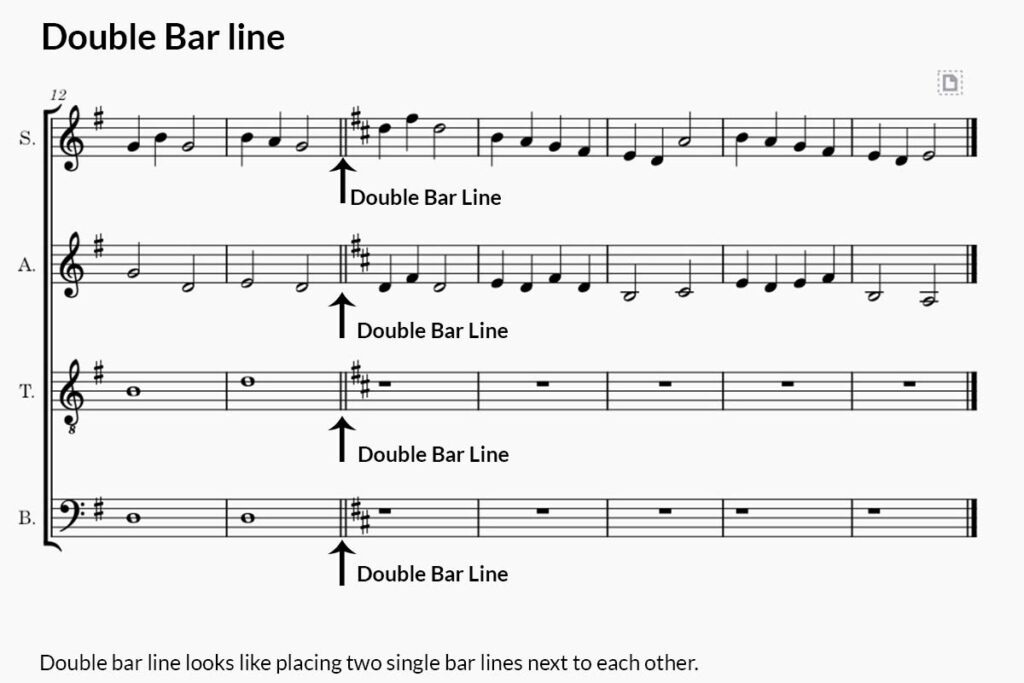What Is A Bar Line In Music Notation?

Bar line and Barring In Music
What is a bar line in music is a topic that is not difficult but needs a clear understanding of what barring is in music notation. Normally, barring in music refers to dividing a piece of music into equal divisions or portions of beats. To do this, sort vertical lines known as bar lines are drawn across the staff line.
In what you need to know about the music staff, we discussed how music can be notated in five straight lines. These lines are called staff (or stave) and we used them to represent the pitches of the notes.
The pitches show how low or high those musical notes are and that determines their respective position on the staff. That is brilliant and really helpful in notating music with the correct pitch.
Specifically, the pitch is just one among few properties that musical sound or tone has. We discussed that in detail with what you need to know about musical tone and sound earlier. However, there is another property known as duration (or time) which forms the basic part of the rhythm.
As a matter of fact, rhythm plays an important role in music and every style of music has its unique rhythmic pattern. This rhythmic pattern is formed by the way we group beats (or pulses) together. This is more elaborate with the time signature that governs the beat pattern in musical notation.
In order to keep track of how beats are grouped together, musical notation utilized short vertical lines known as bar lines (or bar line). Bar lines form the major part of barring in music which is the act of dividing music into bars (or measures).
Bar and Bar Lines
The bar specifies the group of beats or maybe notes we want to put into the equal division on a staff. On the other hand, bar line is what we employ in barring the music.
In this article, we will look into what Bars and Bar Lines are in music. This bar (or measure) has already been discussed in time signature in musical notation but we will still look into it here.
Because it is very relevant to our bar line discussion. Moreover, we will discuss different types of bar line we have in music notation.
Bar (Or Measure) In Music
Generally, we all listen to music in one way or the other. We may have a special style of music we listen to but what matters here is that we listen.
And most often, there is this pronounced throb that we feel while listening and sometimes tap our feet to. Also, we clap our hands or nod our heads to this stable throb as we follow along with the music
The steady throb that we tap our foot, or clap our hands to is known as the Beat in music. It is sometimes referred to as a Pulse.
In a well-defined music notation, these beats are grouped together as a basic unit of time into a Bar (or Measures). The way we grouped these beats together is usually established by the time signature of a piece.
However, some beats in each group are normally stronger than the other beats within the same group. This is where the term “accent” comes out in music notation and the first beat of each group is the accent (or stronger) beat.
In other words, the music is divided in equal measures by the number of beats we have from one accent to the other. This is typically known as a bar in music.
Basically, bar and measure are the same and can be used interchangeably. And we can also say that bar is a complete beats cycle as defined by the time signature.
Bar line

The understanding of what the bar (or measure) in music is will lead to the bar line. So in this section, we will define bar lines and see how it’s related to bar (or measure) in music notation.
What is Bar Line?
The bar lines are short vertical lines that cut across the five horizontal staff lines in music notation. Specifically, these bar lines are used to divide a piece of music into equal portions of beat.
These equal portions of beats between the bar lines are called Bars or Measure.
Therefore, we can also define a bar (or measure) as a portion of music between two bar lines. And also, we can call the music between two bar lines a bar or measure.
Note that the number of beats we can have inside each and every bar lines is defined by the time signature.
Here we can see the relationship between bar and bar lines. Specifically, the bar line is the symbol we use to establish bar (or measure) in staff music notation.
Moreover, bar lines are the lines drawn vertically across the staff to indicate the position of accent. In music, bar lines are not drawn anyhow.
Usually, a bar line is drawn before each regular recurring strong beat. Thus, in every piece of music, the positions of the accented beats are shown by the bar lines.
Important of Bar lines in music
Bar lines are very useful in the sense that they keep the music notation organized into smaller blocks of beats.
Bar lines allow music performers to grab the information on the piece better by reading smaller units of the music at a time.
These smaller blocks of beats will assist us in properly counting the beats. Also, it will allow us to know where we are on the piece of music at any time.
Without bar lines, reading of musical pieces on staff notation can lead to a mega confusion. For instance, it is much easier to count 1-2-3-4 again and again for common time signatures than to count continuous figures for each beat in a piece.
Barring of music with bar lines assist multiple musicians to keep track of the piece and know where to come in for their individual notes.
Types of Bar lines
In staff music notation, we have different types of bar line that we can use for the different occasions in music contexts. In this section, we will discuss different types of bar lines that we have and how to use them in music notation.
This is necessary because using bar line in music contexts is guided by some notation rules.
The list of
- Single bar line
- Double bar line
- Ending bar line
- Dashed bar line
- Repeat start bar line
- Repeat End bar line
Single Bar line

This is a common, vertical, and standard bar line that we have all over the piece. It is sometimes referred to as a normal bar line. It is very useful to divide music into separate blocks of beats.
The single bar line will start from the topmost horizontal staff line, cut across the three middle lines, and stop on the fifth (or the last) line. This bar line specifies the beginning of a bar and the end of another bar. Specifically, it detaches one bar from the subsequent one.
Double Bar line

Double bar line looks like placing two single bar lines next to each other.
This is a special bar line in music notation that is used to show the end of a section within a piece. Also, it is used to introduce the beginning of another section.
For instance, when a key is changed within a musical piece, a double bar line is employed to end the old key and start the new key.
End Bar line

This is a sort of double bar line but with a thicker vertical line instead of two normal bar lines. The width of the first one is just like a single bar line while the width of the second line is thicker.
End bar line is also known as the “Final double” bar line or “Final” bar line. Specifically, it is employed to mark the end of a piece in music notation. Also, used sometimes to mark the end of a movement.
Dotted Bar line
This is a bar line created just like a single bar line in thickness and length but with dots. So it has some little gaps in between instead of a straight stroke of a solid line.
The bar line is employed to subdivide a complex bar or measure into a smaller section to make reading the music easier.
For instance, when a measure is virtually divided into two but/and we still want to hold onto one measure.
A dotted bar line is normally used here to do them justice by partially bisecting the measure without creating two measures.
The dotted bar line is also known as the dashed bar line.
Repeat Bar lines

This is another type of bar line in staff music notation. However, repeat bar lines are special bar lines used to specify a measure or group of measures that should be repeated in music.
Repeat bar line is of two types. We have started (or left) repeat bar line and end (or right) repeat bar line.
Specifically, the two repeat bar line are normally used together to enclose the section of measures that need to be repeated.
The end repeat bar line will tell the performer that music needs to be repeated from the start repeat bar line. However, if there is no start repeat bar line, the repeat will start from the first measure of the piece or section.
Start (Or Left) Repeat Bar line

This bar line specifies the beginning of a repeat section and it is written with two normal bar lines. Then followed immediately by two or four dots within the space between the five horizontal staff lines.
The first of the two normal bar lines is thicker than the second one. That means the left side bar line has more width than the right one, hence the Left Repeat Bar line.
This start repeat bar line is normally followed by the end repeat bar line at a point within the piece.
End (Or Right) Repeat Bar line

This bar line is used to specify the end of a repeat section within the piece. The end repeat bar line is written with two normal bar lines with the second line thicker than the first one.
Note that this is the opposite of the start repeat bar line. So it starts with two or four dots within the space between the five horizontal staff lines. Then followed immediately by two normal bar lines with the second line thicker than the first.
The second of the two normal bar lines is thicker than the first one. That means the right-hand side bar line has more width than the left one, hence Right Repeat Bar line.
This end repeat bar line can be preceded by a start repeat bar line at a point within the piece. And sometimes, it stands alone to start the repeat from the first measure of the section or entire piece.
At Phamox Music, we go all out for exactness and honesty. For this purpose, if by any means you found any possible glitch, be it factual, editorial or something that we need to update, kindly contact us.
If you find the information provided in this post, What is a Bar Line in Music, interesting and helpful, kindly share it with someone you know who might need it








What a lot of verbiage! A bar-line is simply an instruction to play the next note louder! (As the clapping test in Grade 1)
lol no it’s not what shit are you on
nvm ur on Grade 1.